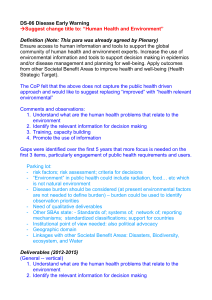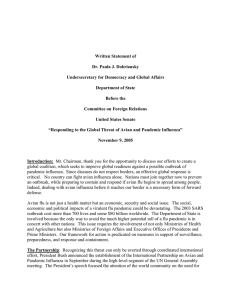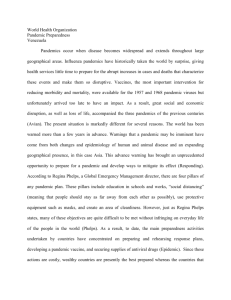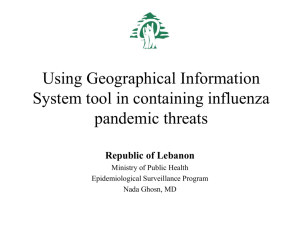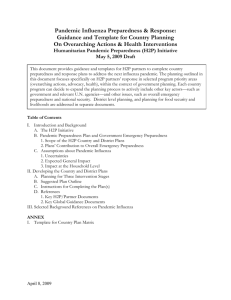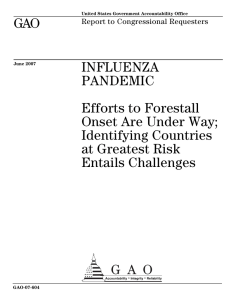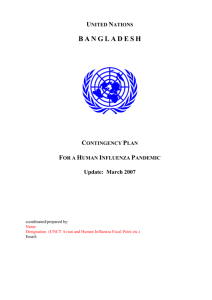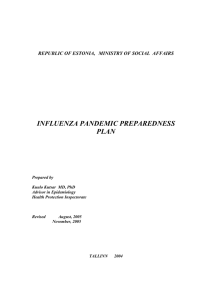DOC - Europa
advertisement
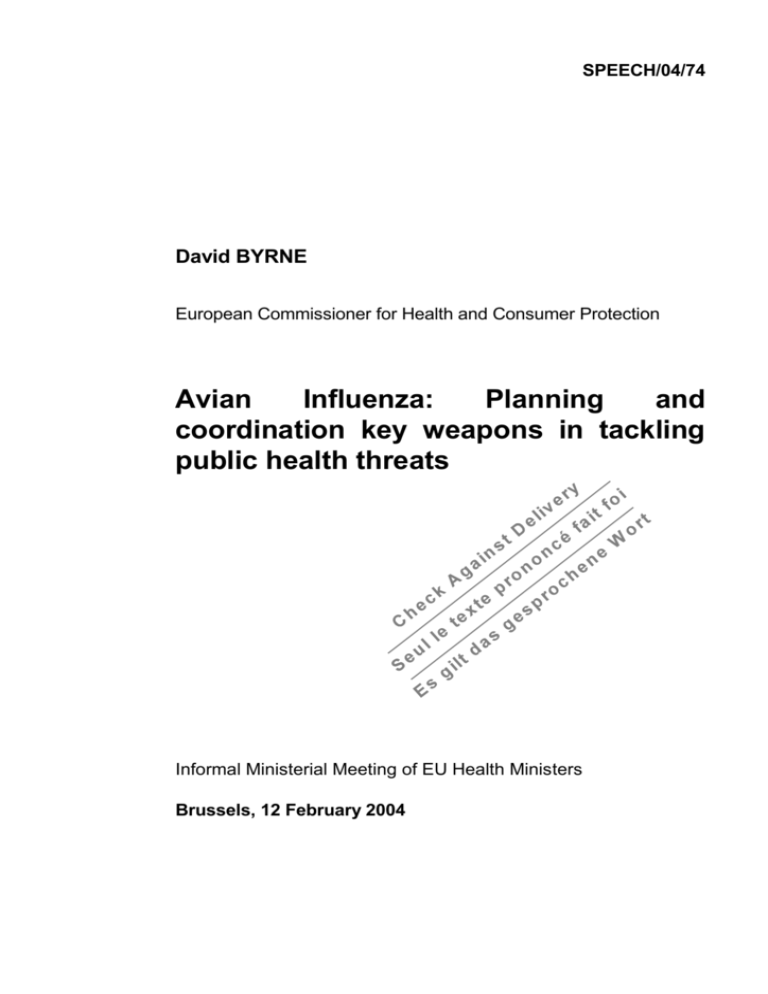
SPEECH/04/74 David BYRNE European Commissioner for Health and Consumer Protection Avian Influenza: Planning and coordination key weapons in tackling public health threats Informal Ministerial Meeting of EU Health Ministers Brussels, 12 February 2004 The calling of this meeting of European health ministers, to take stock of the evolving avian influenza outbreak, confirms that our citizen’s health is best protected, when we work quickly, decisively and together. In general, we know that an influenza pandemic is highly likely to occur, and is a matter of when, not if. Factors which are increasing this risk include - increasing global travel, the encroachment of expanding populations on previously wild habitats, and the close daily proximity of people and animals in parts of the developing world. This is the modern reservoir for the next pandemic. Zoonoses present a grave emerging threat to the world’s health. At the global level we will continue to support the efforts of the WHO under Dr. Lee’s leadership, to develop effective responses with the OIE and the FAO. In the EU, we must redouble our efforts to develop an integrated zoonoses strategy capable of responding to the scale and complexity of this emerging threat. We need an instrument capable of addressing the whole transmission chain, from animals to humans. The evolution of the disease in Asia in recent weeks, and indeed perhaps months, underlines the importance of effective coordinated action. Recently, when I had the opportunity to examine the situation at first hand in Vietnam and Thailand, the importance of effective surveillance and transparent coordination and response was all too clear. In imposing an immediate EU import ban, we acted to halt the progress of this devastating disease. Contingency plans are in place to ensure a swift EU reaction to any other suspect cases. Dr. Lee has given us a clear report on the current state of play. We cannot yet say that it is under control. The situation remains one of great concern. Without adequate control measures the present epidemic could eventually lead to a new influenza pandemic. There is, at present, no indication that human-to-human transmission has taken hold. Therefore, we will closely examine the analysis of the unfortunate Vietnamese family. Our experience in Europe confirms that draconian measures are necessary to successfully address an ongoing avian flu epidemic in poultry. The large scale culling of poultry is the single most successful measure in stamping out this disease. Support to Countries in Asia The economic and social impact of this epidemic will be significant. Countries in a position to do so have a duty, and an interest, to assist the countries that have been hardest hit. In return, we must press for better surveillance, controls and for more transparency. The Commission has sent an animal health expert and two public health experts to Vietnam to assist in combating the disease, in collaboration with the WHO. In addition Member States have sent experts to other affected countries. The Commission is making a major Community contribution to support Vietnamese efforts against avian influenza by financing up to 1 million Euros of protective and laboratory equipment. 2 Animal health During 2003 the Commission funded an Avian Influenza survey by Member States in poultry and wildbirds. We will continue surveillance for strains that might mutate into highly pathogenic strains of the virus. Backed by this evidence, the Commission will adopt a new legislative proposal for the control of Avian Influenza later this year. Early Warning Response System On human health, for some time the Commission has been working closely with Member States to put a series of instruments and policies in place. In responding to Bioterrorism and SARS we have gained valuable experience. For example, we have developed the communicable diseases network, the Early Warning and Response system and the Health Security Committee and Action lan. These systems have worked well, given their current capacity. Of course the system is only as good as the quality and timeliness of the information provided to it. I have found the Community’s Early Warning and Response System to be very useful, given the flow of information and consultation between experts. From the latest teleconference on Tuesday of this week, I understand that two Member States (D, A) recommend vaccination prior to travel. And that all Member States are confident of their rapid diagnostic capacity (5-7 hours) for avian influenza. At this stage of development, nobody feels the need to institute controls or screening for travellers coming from the affected area. Nor has it been felt necessary to advise such travellers to report symptoms after arrival to health authorities or professionals. This kind of timely expert information exchange is essential to ensure a coherent and effective response. Community Influenza Pandemic Preparedness Plan We will soon add another key planning instrument. The Commission will soon adopt a working paper on “influenza pandemic preparedness and response planning in the Community”. The paper will address key issues of co-ordination and the availability of vaccines and anti-virals. We intend this to be a consultative document to promote effective policies and measures within the EU. The paper explains the stages of an influenza pandemic definitions. It also sets out the main objectives for action. based on WHO Moreover, it outlines the role of the Commission and the Member States in pandemic preparedness planning. It will define key actions at pre-determined phases and levels in the main areas of: - management and co-ordination, surveillance, prevention, mitigation and response, 3 communication, civil protection and research. Particular reference is made to animal health legislation and actions to prevent and control influenza in animals. Planning and coordination will be key weapons in tackling any future pandemic. Some reflection is needed to think through how best to deal with issues such as restrictions of movement, travel advice, aggressive surveillance and case management. Moreover, the availability and use of vaccines and anti-virals, which will be essential in effectively facing up to a pandemic, will have to be examined urgently. This is especially important given current industrial capacity. The paper has been prepared following extensive consultations with the members of the Communicable Diseases Network Committee. I expect that we will have an opportunity to examine it in more detail in Council at a later date. In addition to all this, the Commission is continuing to monitor the current seasonal influenza epidemic through the European Influenza Surveillance Scheme (EISS). This provides valuable data on seasonal influenza activity in 22 European countries. ECDC Finally let me come to the latest addition to our armoury. The European Parliament’s green light to the European Centre for Disease Prevention and Control or ECDC, is very timely news. This and the Council’s constructive approach, paves the way for the Centre to become operational in early 2005. Conclusion Our experiences with bioterrorism and SARS, show the value of sharing information and working closely together at Community level to plan and respond to major public health threats. Based on this experience, I believe that we should apply this pragmatic approach to the next steps on influenza preparedness cooperation. In particular: - Political agreement to inform one another in advance of taking any measures would be helpful. Following the bioterrorism approach, we would ask our people to meet with industry to look at capacity issues for key treatments (vaccines/antivirals etc). Following publication of the Community Influenza Pandemic Preparedness Document, we could ask our experts to discuss practical conclusions. Indeed we may wish to pool our experience in how best to address the issue of risk communication. Finally we need to develop more integrated policy approaches between animal and human health experts on the issue of Zoonoses Our experts could look into these issues and report back to us at the June Council. In all of this activity we are united in the knowledge that those who plan well, will respond best. Thank you. 4




